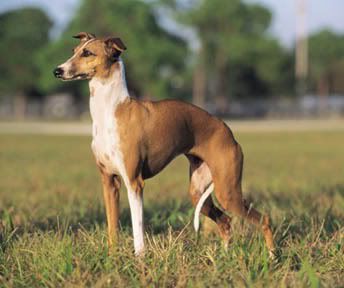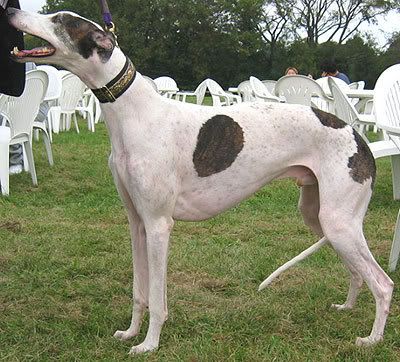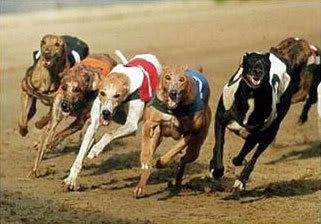Post by charmingnancy on Mar 9, 2009 14:43:05 GMT -5
Greyhound
Group: 2- Hounds
Origin: United Kingdom
Purpose: Coursing game and racing

Description:
The Greyhound is a breed of hunting dog that has been primarily bred for coursing game and racing, but with a recent resurgence of popularity increasingly as a pedigree show dog and family pet. It is a soft and intelligent breed that often becomes attached to its owners. It is the fastest breed of dog. A combination of long, powerful legs, deep chest, flexible spine and slim build allows it to reach speeds of around 70 km/h (43.5 mph).
Appearance- Breed Standards:
Coat and Colour: Coat short, smooth, and firm in texture. Colour immaterial.
Head: Long and narrow, fairly wide between the ears, scarcely perceptible stop, little or no development of nasal sinuses, good length of muzzle, which should be powerful without coarseness. Teeth very strong and even in front. Eyes dark, bright, intelligent, indicating spirit. Ears small and fine in texture, thrown back and folded, except when excited, when they are semi-pricked.
Neck: Long, muscular, without throatiness, slightly arched, and widening gradually into the shoulder.
Forequarters: Shoulders placed as obliquely as possible, muscular without being loaded. Forelegs perfectly straight, set well into the shoulder, neither turned in nor out, pasterns strong.
Body: Back muscular and broad, well arched. Chest deep, and as wide as consistent with speed, fairly well-sprung ribs. Loins have good depth of muscle, well cut up in the flanks.
Hindquarters: Long, very muscular and powerful, wide and well let down, well-bent stifles. Hocks well bent and rather close to ground, wide but straight fore and aft. Feet hard and close, rather more hare than cat-feet, well knuckled up with good strong claws.
Tail: Long, fine, and tapering with a slight upward curve.
Scale of Points
General symmetry and quality- 10
Head and neck- 20
Chest and shoulders- 20
Back- 10
Quarters- 20
Legs and feet- 20
TOTAL= 100
Size:
Dogs, 65-70 lb. (29-32 kg); bitches, 60-65 lb. (27-29 kg). Males are usually 71 to 76 cm (28 to 30 inches) tall at the withers and females tend to be smaller with shoulder heights ranging from 68 to 71 cm (27 to 28 inches).

Temperament:
Although Greyhounds are extremely fast and athletic, and despite their reputation as racing dogs, they are not high-energy dogs. They are sprinters, and although they love running, they do not require extensive exercise. Most are quiet, gentle animals. Greyhounds bark very little, which helps in suburban environments, and are usually as friendly to strangers as they are with their own family. An adult Greyhound will stay healthy and happy with a daily walk of as little as 20 to 30 minutes. Greyhounds have been referred to as "Forty-five mile per hour couch potatoes." Greyhound owners and adoption groups generally consider Greyhounds to be wonderful pets. They are pack-oriented dogs, which means that they will quickly adopt humans into their pack as alpha. They can get along well with children, dogs and other family pets.
Health:
Greyhounds are typically a healthy and long-lived breed, and hereditary illness is rare. Some Greyhounds have been known to develop esophageal achalasia, bloat, and osteosarcoma. Because the Greyhound's lean physique makes it ill-suited to sleeping on hard surfaces, owners of companion Greyhounds generally provide soft bedding; without bedding, Greyhounds are prone to develop painful skin sores.
Due to the unique physiology and anatomy of greyhounds, a veterinarian who understands the issues relevant to the breed is generally needed when the dogs need treatment, particularly when anaesthesia is required. Greyhounds cannot metabolize barbiturate-based anesthesia as other breeds can because they have lower amounts of oxidative enzymes in their livers. Greyhounds demonstrate unusual blood chemistry, which can be misread by veterinarians not familiar with the breed; this can result in an incorrect diagnosis.
Greyhounds have higher levels of red blood cells than other breeds. Since red blood cells carry oxygen to the muscles, this higher level allows the hound to move larger quantities of oxygen faster from the lungs to the muscles. Greyhounds have lower levels of platelets than other breeds. Veterinary blood services often use Greyhounds as universal blood donors.
Average Lifespan:
Greyhounds typically live 10–13 years.

History:
The breed's origin is romantically reputed to be connected to ancient Egypt, where depictions of smooth-coated sighthound types have been found which are typical of Saluki (Persian Greyhound) or Sloughi (tombs at Beni Hassan circa 2000BC). However, analyses of DNA reported in 2004 suggest that the Greyhound is not closely related to these Oriental breeds, but is a close relative to herding dogs. Historical literature on the first sighthound in Europe (Arrian), the vertragus, the probable antecedant of the Greyhound, suggests that the origin is with the ancient Celts from Eastern Europe or Eurasia. All modern, thoroughbred pedigree Greyhounds, are derived from the greyhound stock recorded and registered, firstly in the private 18th Century then public 19th Century studbooks, which ultimately were registered with Coursing, Racing, and Kennel Club authorities of the United Kingdom.
Historically, these sighthounds were used primarily for hunting in the open where their keen eyesight is valuable. It is believed that they (or at least similarly-named dogs) were introduced to the area now known as the United Kingdom in the 5th and 6th century BC from Celtic mainland Europe although the Picts and other hunter gatherer tribes of the Northern area (now known as Scotland) were believed to have had large hounds similar to that of the Deerhound before the 6th century BC.
The name "Greyhound" is generally believed to come from the Old English grighund. "Hund" is the antecedent of the modern "hound", but the meaning of "grig" is undetermined, other than in reference to dogs in Old English and Norse. Its origin does not appear to have any common root with the modern word "grey" for colour, and indeed the Greyhound is seen with a wide variety of coats. This may be confusing, however, as the Deerhound and Irish wolfhound are more commonly grey in colour and possibly the true origins of the Greyhound. However, the Deerhound and Irish wolfhound, the latter being a reconstructed breed, probably cannot have had any genetic influence on the much older Greyhound. It is known that in England during the medieval period, Lords and Royalty keen to own Greyhounds for sport, requested they be bred to colour variants that made them easier to view and identify in pursuit of their quarry.[citation needed] The lighter colours, patch-like markings and white appeared in the breed that was once ordinarily grey in colour. The Greyhound is the only dog mentioned by name in the Bible; the King James version names the Greyhound as one of the Four things stately in the Proverbs. However, in the modern version of the Bible this has been changed to strutting rooster, which appears to be a more correct translation of the Hebrew term זַרְזִיר (zarzir).
According to Pokorny the English name "greyhound" does not mean "gray dog/hound", but simply "fair dog". Subsequent words have been derived from the Proto-Indo-European root *g'her- 'shine, twinkle': English gray, Old High German gris 'grey, old', Old Icelandic griss 'piglet, pig', Old Icelandic gryja 'to dawn', gryjandi 'morning twilight', Old Irish grian 'sun', Old Church Slavonic zorja 'morning twilight, brightness'. The common sense of these words is 'to shine; bright'.
The Greyhound Lines bus company, in keeping with their logo which sports a racing Greyhound, occasionally airs television commercials starring a talking computer-generated greyhound. The greyhound in these commercial shorts is often noted for his dry, deadpan wit. In holiday season commercials, the greyhound also sings about fare discounts, the song being set to a Christmas carol.
Sources:
CKC
Wikipedia
Pictures:
Photobucket
Group: 2- Hounds
Origin: United Kingdom
Purpose: Coursing game and racing

Description:
The Greyhound is a breed of hunting dog that has been primarily bred for coursing game and racing, but with a recent resurgence of popularity increasingly as a pedigree show dog and family pet. It is a soft and intelligent breed that often becomes attached to its owners. It is the fastest breed of dog. A combination of long, powerful legs, deep chest, flexible spine and slim build allows it to reach speeds of around 70 km/h (43.5 mph).
Appearance- Breed Standards:
Coat and Colour: Coat short, smooth, and firm in texture. Colour immaterial.
Head: Long and narrow, fairly wide between the ears, scarcely perceptible stop, little or no development of nasal sinuses, good length of muzzle, which should be powerful without coarseness. Teeth very strong and even in front. Eyes dark, bright, intelligent, indicating spirit. Ears small and fine in texture, thrown back and folded, except when excited, when they are semi-pricked.
Neck: Long, muscular, without throatiness, slightly arched, and widening gradually into the shoulder.
Forequarters: Shoulders placed as obliquely as possible, muscular without being loaded. Forelegs perfectly straight, set well into the shoulder, neither turned in nor out, pasterns strong.
Body: Back muscular and broad, well arched. Chest deep, and as wide as consistent with speed, fairly well-sprung ribs. Loins have good depth of muscle, well cut up in the flanks.
Hindquarters: Long, very muscular and powerful, wide and well let down, well-bent stifles. Hocks well bent and rather close to ground, wide but straight fore and aft. Feet hard and close, rather more hare than cat-feet, well knuckled up with good strong claws.
Tail: Long, fine, and tapering with a slight upward curve.
Scale of Points
General symmetry and quality- 10
Head and neck- 20
Chest and shoulders- 20
Back- 10
Quarters- 20
Legs and feet- 20
TOTAL= 100
Size:
Dogs, 65-70 lb. (29-32 kg); bitches, 60-65 lb. (27-29 kg). Males are usually 71 to 76 cm (28 to 30 inches) tall at the withers and females tend to be smaller with shoulder heights ranging from 68 to 71 cm (27 to 28 inches).

Temperament:
Although Greyhounds are extremely fast and athletic, and despite their reputation as racing dogs, they are not high-energy dogs. They are sprinters, and although they love running, they do not require extensive exercise. Most are quiet, gentle animals. Greyhounds bark very little, which helps in suburban environments, and are usually as friendly to strangers as they are with their own family. An adult Greyhound will stay healthy and happy with a daily walk of as little as 20 to 30 minutes. Greyhounds have been referred to as "Forty-five mile per hour couch potatoes." Greyhound owners and adoption groups generally consider Greyhounds to be wonderful pets. They are pack-oriented dogs, which means that they will quickly adopt humans into their pack as alpha. They can get along well with children, dogs and other family pets.
Health:
Greyhounds are typically a healthy and long-lived breed, and hereditary illness is rare. Some Greyhounds have been known to develop esophageal achalasia, bloat, and osteosarcoma. Because the Greyhound's lean physique makes it ill-suited to sleeping on hard surfaces, owners of companion Greyhounds generally provide soft bedding; without bedding, Greyhounds are prone to develop painful skin sores.
Due to the unique physiology and anatomy of greyhounds, a veterinarian who understands the issues relevant to the breed is generally needed when the dogs need treatment, particularly when anaesthesia is required. Greyhounds cannot metabolize barbiturate-based anesthesia as other breeds can because they have lower amounts of oxidative enzymes in their livers. Greyhounds demonstrate unusual blood chemistry, which can be misread by veterinarians not familiar with the breed; this can result in an incorrect diagnosis.
Greyhounds have higher levels of red blood cells than other breeds. Since red blood cells carry oxygen to the muscles, this higher level allows the hound to move larger quantities of oxygen faster from the lungs to the muscles. Greyhounds have lower levels of platelets than other breeds. Veterinary blood services often use Greyhounds as universal blood donors.
Average Lifespan:
Greyhounds typically live 10–13 years.

History:
The breed's origin is romantically reputed to be connected to ancient Egypt, where depictions of smooth-coated sighthound types have been found which are typical of Saluki (Persian Greyhound) or Sloughi (tombs at Beni Hassan circa 2000BC). However, analyses of DNA reported in 2004 suggest that the Greyhound is not closely related to these Oriental breeds, but is a close relative to herding dogs. Historical literature on the first sighthound in Europe (Arrian), the vertragus, the probable antecedant of the Greyhound, suggests that the origin is with the ancient Celts from Eastern Europe or Eurasia. All modern, thoroughbred pedigree Greyhounds, are derived from the greyhound stock recorded and registered, firstly in the private 18th Century then public 19th Century studbooks, which ultimately were registered with Coursing, Racing, and Kennel Club authorities of the United Kingdom.
Historically, these sighthounds were used primarily for hunting in the open where their keen eyesight is valuable. It is believed that they (or at least similarly-named dogs) were introduced to the area now known as the United Kingdom in the 5th and 6th century BC from Celtic mainland Europe although the Picts and other hunter gatherer tribes of the Northern area (now known as Scotland) were believed to have had large hounds similar to that of the Deerhound before the 6th century BC.
The name "Greyhound" is generally believed to come from the Old English grighund. "Hund" is the antecedent of the modern "hound", but the meaning of "grig" is undetermined, other than in reference to dogs in Old English and Norse. Its origin does not appear to have any common root with the modern word "grey" for colour, and indeed the Greyhound is seen with a wide variety of coats. This may be confusing, however, as the Deerhound and Irish wolfhound are more commonly grey in colour and possibly the true origins of the Greyhound. However, the Deerhound and Irish wolfhound, the latter being a reconstructed breed, probably cannot have had any genetic influence on the much older Greyhound. It is known that in England during the medieval period, Lords and Royalty keen to own Greyhounds for sport, requested they be bred to colour variants that made them easier to view and identify in pursuit of their quarry.[citation needed] The lighter colours, patch-like markings and white appeared in the breed that was once ordinarily grey in colour. The Greyhound is the only dog mentioned by name in the Bible; the King James version names the Greyhound as one of the Four things stately in the Proverbs. However, in the modern version of the Bible this has been changed to strutting rooster, which appears to be a more correct translation of the Hebrew term זַרְזִיר (zarzir).
According to Pokorny the English name "greyhound" does not mean "gray dog/hound", but simply "fair dog". Subsequent words have been derived from the Proto-Indo-European root *g'her- 'shine, twinkle': English gray, Old High German gris 'grey, old', Old Icelandic griss 'piglet, pig', Old Icelandic gryja 'to dawn', gryjandi 'morning twilight', Old Irish grian 'sun', Old Church Slavonic zorja 'morning twilight, brightness'. The common sense of these words is 'to shine; bright'.
The Greyhound Lines bus company, in keeping with their logo which sports a racing Greyhound, occasionally airs television commercials starring a talking computer-generated greyhound. The greyhound in these commercial shorts is often noted for his dry, deadpan wit. In holiday season commercials, the greyhound also sings about fare discounts, the song being set to a Christmas carol.
Sources:
CKC
Wikipedia
Pictures:
Photobucket

